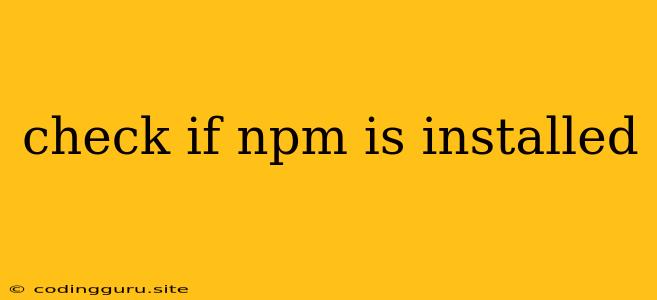How to Verify if npm is Installed on Your System
Node Package Manager (npm) is a vital tool for JavaScript developers. It's the default package manager for Node.js, responsible for managing project dependencies, installing packages, and publishing your own packages to the world. But before you can leverage its power, you need to ensure that npm is correctly installed on your system.
Let's explore the methods to check if npm is already installed on your machine:
1. Using the Command Line
The most straightforward way to verify npm's presence is by using your system's command line interface (CLI). Open your terminal or command prompt and type the following command:
npm --version
What to Expect:
-
Success: If npm is installed, you'll see the current version number of npm displayed on your terminal. For example:
6.14.15 -
Failure: If npm is not installed, you'll get an error message like "command not found" or "npm: command not found".
2. Checking the Node.js Installation Directory
If you're not sure about npm's installation status, you can directly check the Node.js installation directory.
- Windows: Typically, Node.js is installed in
C:\Program Files\nodejs. Thenpmexecutable should be located within this directory. - macOS & Linux: Node.js is usually installed under
/usr/local/bin. Check if thenpmexecutable exists within this directory.
3. Using a Package Manager
On operating systems like Ubuntu or Debian, you can use the package manager to verify if npm is installed:
-
Ubuntu & Debian: Execute the following command in your terminal:
dpkg -l | grep npmIf npm is installed, you'll see an output similar to this:
ii npm 8.1.0-1 amd64 Node.js package manager
What to Do if npm is Not Installed
If any of the above methods reveal that npm is missing, you need to install Node.js. Since npm is bundled with Node.js, installing Node.js automatically installs npm.
Here's how to install Node.js:
- Visit the official Node.js website:
- Download the appropriate installer: Choose the installer version that matches your operating system (Windows, macOS, or Linux).
- Run the installer: Follow the on-screen instructions to complete the installation process.
- Verify the installation: After installing Node.js, repeat the commands mentioned in the "Using the Command Line" section above to confirm npm's presence.
Troubleshooting Tips
-
Path Environment Variable: If you encounter issues like "command not found" after installing Node.js, ensure that the Node.js installation directory is added to your system's PATH environment variable. This allows your system to find npm's executable.
-
Permissions: Sometimes, you may face permission errors when trying to use npm. If you're using a Unix-based system, check if you have the necessary permissions to execute commands in the
usr/local/bindirectory. -
Outdated npm: If you're using an older version of npm, consider updating it to the latest version for better performance and security:
npm install -g npm
Conclusion
Verifying if npm is installed is a crucial first step before embarking on any Node.js development project. By following the methods outlined above, you can ensure that npm is readily available and ready to empower your JavaScript development journey.
